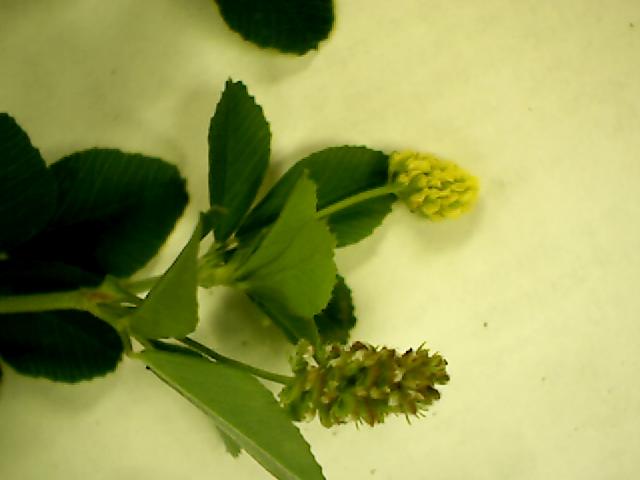If I'd see a patch of flowering clover or the tiny star-like flowers of stitchwort (Stellaria), I felt compelled to mow around them, come back to the patches with lawn clippers to cut protruding blades of grass and try to make the weeds as inconspicuous as possible, hoping to sneak my conservation effort past my father's critical eye. But it never worked. Even though I tried to point out that stitchwort was rich in vitamin C, in his eyes there was a place for everything, and only grass should be grown in lawns.

I discovered that one of my father's many kindred spirits lives on my street. A few nights ago while walking my dog, I noticed he was destroying an attractive patch of black medic from his lawn that bordered the sidewalk.
With the friendliest tone I could manage, I asked him, "Did you know that plant is a member of the legume family, and it makes its own fertilizer."
"Yes, but it's not nice", he replied.
I sensed it was hopeless, but my compulsion to explain science obliged me to continue.
"The nitrogen from the air gets converted to useful ammonium by a helpful bacterium in that plant's roots," I said.
"Yes, but it's not nice.", he repeated, still friendly.
For the sake of neighborly relations, now seemed like a good time to let go, so I smiled and concluded, "Oh well...it's your property".
So, alas, unable to spark a street discussion of the intricacies of black medic, I turn once again to the laptop keyboard. Medicago lupilina, is a member of the pea family (Leguminosae or Fabaceae). A close look at the cluster of yellow flowers reveals a set of miniature pea-like flowers. The bases, sepals and stamens are fused together into a cup-like structure, and you have to lift the cup and have exceptional closeup eyesight to see its reproductive parts.

A key ecological feature of this family is the nitrogen-fixing ability shared by most of its 18 to 20 thousand members. It happens through a symbiotic association with Rhizobium, which infect legume roots and form nodules, where in exchange for sugars, the bacteria use an anaerobic reaction to convert diatomic nitrogen into ammonium ion (NH4+). In the reaction, the
nitrogen is "fixed", because plants cannot
convert relatively inert N2 into needed amino acids, but ammonium will do the trick. But free nitrogen gas has an oxidation number of zero, and it gets converted into NH4+ , whose nitrogen atom has an oxidation number of (-3). This reduction process would not occur if the common oxidizer in air, oxygen, would come into contact with the nitrogen-fixing enzymes.
The bacteria get around this dilemma by making use of leghemoglobin(LEG), a pigment similar in structure to our hemoglobin but with a higher affinity for oxygen. In the diagram, notice that the pigment is actually in the nodule, outside of the bacterial cell wall, away from the enzyme complex (NC).
The small amount of oxygen is then delivered to the bacteria's respiratory chain (RC), allowing several ATP molecules to be fed into the enzyme complex, where the reducing agent, NADH, converts the nitrogen into ammonium. The latter is released in aqueous form into the host cell , where it is converted into glutamine, asparagine and urea derivatives of the general form,R-CO-NH-CO NH2, where R can be a different hydrocarbon group.
These products are then transported to the rest of the plant through the xylem (not with sugars, which are distributed by the phloem), and with the abundance of these protein-building blocks, it is not surprising that the seeds of the black, ripe pods of black medic, like those of beans, lentils and other legumes, are rich in proteins.
Compared to other plants, legumes seem to be more sensitive to increases in carbon dioxide levels.(Incidentally, although we have not yet crossed the average global concentration of 400 ppm, we have hit the seasonal peak at some stations.) Some species produce bigger seeds when the atmosphere is CO2-enriched, and in general, at least in soybeans, extra carbon facilitates the fixation of nitrogen, provided that there are no other stresses such as limited nutrient availability or drought.
I guess that's another reason why my neighbor was digging up his black medic---better get to it before climate change amplifies his problem.
Photo credits: pictures 3 and 4: author; 1, and 5: Wikipedia public domain;
Sources:
Will Elevated Carbon Dioxide Concentration Amplify the Benefits of Nitrogen Fixation in Legumes?1
Plant Physiology November 2009 vol. 151 no. 3 1009-1016 (available in its entirety, free of charge)
The Botanical Garden Volume II: Perennials and Annuals. Roger Phillips and Martyn Rix. Firefly. 2002